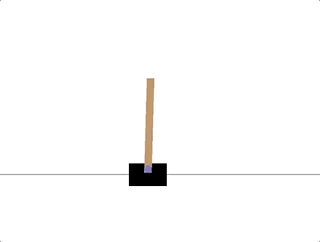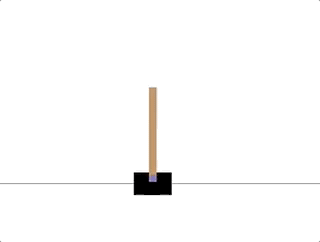TensorFlow 2.0 (六) - 监督学习玩转 OpenAI gym game
源代码/数据集已上传到
Github - tensorflow-tutorial-samples
这篇文章是 TensorFlow 2.0 Tutorial 入门教程的第六篇文章,介绍如何使用 TensorFlow 2.0 搭建神经网络(Neural Network, NN),使用纯监督学习(Supervised Learning)的方法,玩转 OpenAI gym game。示例代码基于 Python 3 和 TensorFlow 2.0 。
OpenAI gym是一个开源的游戏模拟环境,主要用来开发和比较强化学习(Reinforcement Learning, RL)的算法。这篇文章是 Tensorflow 2.0 系列使用 gym 的第一篇文章,网上介绍强化学习玩 gym 的文章比较多,而纯监督学习的文章极少。我们先使用纯监督学习的算法,一起感受 gym 的魅力吧。
1
2
3
4
5
| pip install tensorflow==2.0.0-beta0
pip install gym
# 如果你有多个Python环境,需要指定
# python3 -m pip install tensorflow==2.0.0-beta0
# python3 -m pip install gym
|
OpenAI gym 初尝试
我们先对 OpenAI 的 gym 库的几个核心概念作个简单介绍。
想象一下你在玩贪吃蛇,你需要分析当前游戏的状态(State),例如你所处的位置,周围的障碍物等,才能够决定下一步的动作(Action),上下左右。那你每走一步,就会得到一个奖励(Reward)。这个奖励可能是正向奖励(Positive Reward),也可能是负向奖励(Negative Reward),比如撞到了障碍物。重复N次这样的过程,直到游戏结束(Done)。
从整个例子中,可以总结出几个重要的概念,接下来的示例将会使用 OpenAI gym 库提供的 CartPole Game 环境,一起来熟悉CartPole 游戏中的这几个概念的含义吧。先直接给一个可以运行看效果的示例,这个示例中,Action 是随机选择的。
1
2
3
4
5
6
7
8
9
10
11
12
13
14
15
16
17
18
19
20
| # try_gym.py
# https://geektutu.com
import gym # 0.12.5
import random
import time
env = gym.make("CartPole-v0") # 加载游戏环境
state = env.reset()
score = 0
while True:
time.sleep(0.1)
env.render() # 显示画面
action = random.randint(0, 1) # 随机选择一个动作 0 或 1
state, reward, done, _ = env.step(action) # 执行这个动作
score += reward # 每回合的得分
if done: # 游戏结束
print('score: ', score) # 打印分数
break
env.close()
|
1
2
| $ python3 try_gym.py
score: 14.0
|
| 概念 |
解释 |
示例 |
|---|
| State |
list:状态,[车位置, 车速度, 杆角度, 杆速度] |
0.02,0.95,-0.07,-1.53 |
| Action |
int:动作(0向左/1向右) |
1 |
| Reward |
float:奖励(每走一步得1分) |
1.0 |
| Done |
bool:是否结束(True/False),上限200回合 |
False |
游戏上限是200回合,但是如果是随机选择 Action,就只得了14分,游戏就结束了。
搭建神经网络
我们的目的就是将随机选择 Action 的部分,变为由神经网络模型来选择。神经网络的输入是State,输出是Action。在这里,Action 用独热编码来表示,即 [1, 0] 表示向左,**[0, 1]** 表示向右。这样我们可以方便地使用np.argmax()获取预测的 Action 的值。
1
2
| np.argmax([0.3, 0.7]) # 1,假如神经网络的输出是 [0.3, 0.7],那Action值为1,表示向右。
np.argmax([0.8, 0.2]) # 0,表示向右。
|
接下来我们搭建一个 4 x 64 x 20 x 2 的网络,输入层为4,输出层为2。
1
2
3
4
5
6
7
8
9
10
11
12
13
14
15
16
| # train.py
# https://geektutu.com
import random
import gym
import numpy as np
from tensorflow.keras import models, layers
env = gym.make("CartPole-v0") # 加载游戏环境
STATE_DIM, ACTION_DIM = 4, 2 # State 维度 4, Action 维度 2
model = models.Sequential([
layers.Dense(64, input_dim=STATE_DIM, activation='relu'),
layers.Dense(20, activation='relu'),
layers.Dense(ACTION_DIM, activation='linear')
])
model.summary() # 打印神经网络信息
|
训练数据从哪里来?
神经网络的模型搭好了,那训练数据呢?
随机产生的数据,得分很低,如果不过滤,数据集质量是很低的。
最终的办法:试,一百次不行,就试一万次。
简而言之,我们在过程中计算Score,如果最终得分达到设定的标准,这个分数所对应的所有State和Action就可以作为我们的训练数据了。
1
2
3
4
5
6
7
8
9
10
11
12
13
14
15
16
17
18
19
20
21
22
23
24
25
26
| # train.py
def generate_data_one_episode():
'''生成单次游戏的训练数据'''
x, y, score = [], [], 0
state = env.reset()
while True:
action = random.randrange(0, 2)
x.append(state)
y.append([1, 0] if action == 0 else [0, 1]) # 记录数据
state, reward, done, _ = env.step(action) # 执行动作
score += reward
if done:
break
return x, y, score
def generate_training_data(expected_score=100):
'''# 生成N次游戏的训练数据,并进行筛选,选择 > 100 的数据作为训练集'''
data_X, data_Y, scores = [], [], []
for i in range(10000):
x, y, score = generate_data_one_episode()
if score > expected_score:
data_X += x
data_Y += y
scores.append(score)
print('dataset size: {}, max score: {}'.format(len(data_X), max(scores)))
return np.array(data_X), np.array(data_Y)
|
这样,我们就可以使用generate_training_data函数生成训练集了。
训练并保存模型
神经网络和数据集都准备好了,训练就非常简单了。
1
2
3
4
5
| # train.py
data_X, data_Y = generate_training_data()
model.compile(loss='mse', optimizer='adam', epochs=5)
model.fit(data_X, data_Y)
model.save('CartPole-v0-nn.h5') # 保存模型
|
从运行的结果看,我们最终得到的训练集大小为213,最大分数是108分。
1
2
3
4
5
6
7
8
9
10
11
12
13
14
15
16
17
18
19
20
21
22
23
24
25
26
27
| $ python train.py
Model: "sequential"
_________________________________________________________________
Layer (type) Output Shape Param #
=================================================================
dense (Dense) (None, 64) 320
_________________________________________________________________
dense_1 (Dense) (None, 20) 1300
_________________________________________________________________
dense_2 (Dense) (None, 2) 42
=================================================================
Total params: 1,662
Trainable params: 1,662
Non-trainable params: 0
_________________________________________________________________
dataset size: 213, max score: 108.0
Train on 213 samples
Epoch 1/5
213/213 [==============================] - 0s 713us/sample - loss: 0.4701
Epoch 2/5
213/213 [==============================] - 0s 35us/sample - loss: 0.3920
Epoch 3/5
213/213 [==============================] - 0s 38us/sample - loss: 0.3370
Epoch 4/5
213/213 [==============================] - 0s 39us/sample - loss: 0.2985
Epoch 5/5
213/213 [==============================] - 0s 38us/sample - loss: 0.2745
|
模型测试/预测
1
2
3
4
5
6
7
8
9
10
11
12
13
14
15
16
17
18
19
20
21
22
23
24
| # predict.py
# https://geektutu.com
import time
import numpy as np
import gym
from tensorflow.keras import models
saved_model = models.load_model('CartPole-v0-nn.h5') # 加载模型
env = gym.make("CartPole-v0") # 加载游戏环境
for i in range(5):
state = env.reset()
score = 0
while True:
time.sleep(0.01)
env.render() # 显示画面
action = np.argmax(saved_model.predict(np.array([state]))[0]) # 预测动作
state, reward, done, _ = env.step(action) # 执行这个动作
score += reward # 每回合的得分
if done: # 游戏结束
print('using nn, score: ', score) # 打印分数
break
env.close()
|
1
2
3
4
5
6
| $ python predict.py
using nn, score: 200.0
using nn, score: 200.0
using nn, score: 200.0
using nn, score: 200.0
using nn, score: 200.0
|
模型的结果很不错,每一次都达到了200的满分。
看看效果吧~
在Github - tensorflow-tutorial-samples上提供了.py和.ipynb2种格式的代码。
上一篇 « 博客折腾记(二) - 对搜索引擎的理解
下一篇 » 博客折腾记(三) - 主题设计、彩蛋与阅读量翻倍



